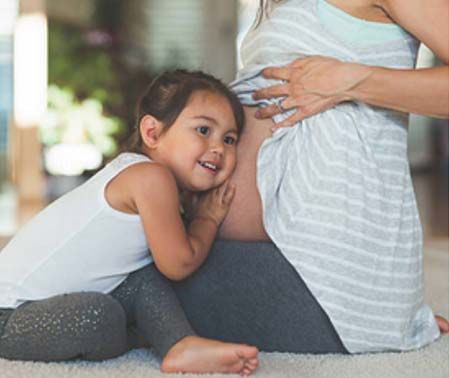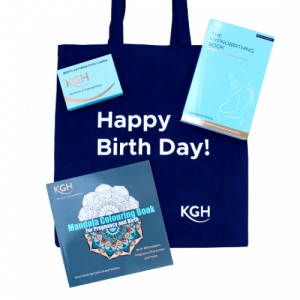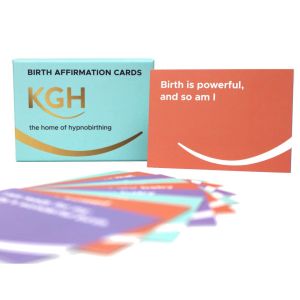
The final ‘third’ of pregnancy, or the final three months, are generally timed from 28 weeks’ gestation and referred to as the third trimester. You may notice that as the pregnancy goes on, and you grow bigger, that you feel more easily tired or clumsier than normal so taking time to do things at an easier pace and learning to relax may be a very good idea. Time spent tuning into your body and your baby is never wasted. You probably feel excited about meeting your baby, and others around you are excited too, but remember that babies come when they are ready! Normal gestation ranges from 37-42 weeks but most spontaneous labours start after 40 weeks (Ref 1).
Bonus time – relax and enjoy
If you are one of the majority whose pregnancy continues beyond the estimated date you were given at the beginning of pregnancy think of this as bonus time – time just for you and your partner or family to enjoy together; time when you can still leave the house without half a truck’s worth of change bags and equipment; time when you can have a long relaxing bath, watch a funny film or take a nap; if you already have children it could be extra time to spend with them without being distracted by the new baby. Enjoy your bonus time.
Growth and development
 During the third trimester your baby is continuing to grow and develop, getting bigger, stronger and more prepared for life outside the womb. The baby’s bones will be hardening as the pregnancy goes on, but the skull bones don’t grow together yet so that baby’s head can mould to fit through the birth canal.
During the third trimester your baby is continuing to grow and develop, getting bigger, stronger and more prepared for life outside the womb. The baby’s bones will be hardening as the pregnancy goes on, but the skull bones don’t grow together yet so that baby’s head can mould to fit through the birth canal.
A baby’s lungs continue to develop right up to birth and even afterwards, but while they are in the womb they get all their oxygen via the placenta and umbilical cord which will continue to provide oxygen for a while after they are born to give them a gentle transition to breathing air.
Birth Preparation
Towards the end of pregnancy, about 36 – 37 weeks, most babies settle into a ‘head down’ position in preparation for birth. Before then a variety of positions are very common and even after 37 weeks babies can still settle head down before birth. (Ref 2)
Baby’s movements are still very important even towards the end of pregnancy – a baby who is well nourished and well oxygenated via a healthy placenta has plenty of energy for moving about, and even if they don’t have much space you will usually feel them wriggling. Babies also have naps between bouts of activity so be aware of what’s normal for your baby. Does she dance about when you eat or drink? Or does he wake up and wiggle when your partner speaks? Or when you get into a warm bath? Tune into your baby and, if you have any concerns that the movements have slowed down, please contact your midwife or hospital straight away so you can be checked over.
Maternity Care in the Third Trimester
If you are having NHS care, then your appointment schedule will follow NICE guidelines (Ref 3). Routine appointments are offered to all women at 28, 34, 36 and 38 weeks, women having their first baby are also offered routine appointments at 31 and 40 weeks. Women who remain pregnant at 41 weeks are offered an appointment then. If you have engaged an independent midwife, you will usually have more frequent appointments depending on the package of care you selected. Appointments with an independent midwife will be unhurried and will allow you to build a relationship with the midwife who will attend your birth. Some NHS areas do have ‘caseloading’ models of care where you also get to know the midwives who will be at your birth, but the appointments may not be as frequent or as long as an independent midwife’s.
What to expect at your appointments
At each NHS appointment your midwife will ask you for a urine sample and to check your blood pressure. These checks are a way of screening for pre-eclampsia – a potentially serious condition which requires careful management. If there are any concerns with these checks, further blood tests and a referral to the hospital may be recommended. Classic symptoms of pre-eclampsia include severe headaches, visual disturbances like flashing lights, sudden swelling, particularly of the hands and face, and severe pain under your ribs. If you get any of these symptoms, or indeed any other sudden and severe illness or pain, it’s important to contact your maternity services urgently. While checking your urine your midwife might discover something that suggests you have a urine infection or too much sugar in your system. If so, she may suggest further tests which should all be explained fully to you.
Fundal height measurement and baby growth
Your midwife will also ask to measure your fundal height – the distance from your pubic bone to the top of your bump – at each appointment. This measurement is most accurate when it’s done by the same person each time and will give an indication of how well baby is growing. Some NHS areas use customised charts to plot the measurements, others don’t. One measurement by itself doesn’t tell us very much and although the average measurement is about 1cm per week of gestation, eg 34cm at 34 weeks, it can vary from woman to woman. The most important thing is that baby is growing at each appointment, so if you measured 32cm at 34 weeks and 34cm at 36 weeks we can see that baby is growing. You will probably be aware of your clothes getting tighter and your bump getting bigger too. If there are any concerns with the measurement of your bump, for example your baby is growing more slowly than expected, then your midwife should offer follow up which may include a scan or a referral to the hospital. Scans in later pregnancy can be useful for checking things like blood flow to and from the placenta (that’s how baby gets all the nutrients and oxygen he needs to grow and develop) but they are not so accurate at estimating the weight of babies. During the appointment your midwife will also ask you about baby’s movements as this is another important way of checking that baby is getting all the nutrients and oxygen that she needs.
NICE (the National Institute for Health and Clinical Excellence that draws up guidelines for all areas of clinical care as well as for pregnancy and birth) do not recommend listening to baby’s heart routinely although your midwife may do this if you ask her to (Ref 3). The best way for you to be reassured about baby’s wellbeing is by monitoring the movements every day.
There are some things that only happen at specific routine appointments:
Routine appointment – 28 weeks:
At 28 weeks you will be offered a repeat blood test to check your iron (haemoglobin) levels. These levels naturally become diluted during pregnancy as blood volume increases but if they are lower than 105g/L you may be offered supplements. Some women find the tablets given on the NHS difficult to tolerate so may prefer to use liquid supplements instead. At the same appointment you will be offered a repeat blood test to check your blood group and antibodies. Women who have rhesus-negative blood may be offered an Anti-D injection at the 28 weeks appointment to protect future pregnancies (some NHS areas have additional early pregnancy tests to check baby’s blood group which makes Anti-D unnecessary for some women). Anti-D may be offered again at 34 weeks in some NHS areas. Anti-D is a blood product and should be discussed fully with you by your medical care-givers.
Routine Appointment – 36 weeks:
At 36 weeks your midwife will ask to ‘palpate’ or feel your bump to work out whether baby has settled into a ‘head down’ (cephalic) position. If baby hasn’t settled head down at this stage (he still might, later) your midwife will discuss with you what is offered in that NHS area. Most areas will offer an ECV (External Cephalic Version) to women with a normal pregnancy. This means an experienced obstetrician or a midwife with additional training and expertise will use their hands on the outside of your abdomen to encourage the baby to roll into a cephalic position. Success rates vary between practitioners and some babies decide they prefer to stay in, or return to, a ‘bottom down’ (breech) position. Some women use hypnosis, acupressure, moxibustion or other complementary therapies which can be a more effective way of encouraging a breech baby to turn than an ECV, and the most effective of all is hypnotherapy which has about an 80% success rate to allow their baby to move into a cephalic position but for some babies it appears the breech position is absolutely the right thing and they don’t move. Only about 4% of babies are breech at term and some of those settle head down before birth (they can change right up to the start of labour and sometimes even in labour itself) but if your baby is one of that 4% your caregivers should discuss plans for birth with you and support you in whatever decision you make. For some people a caesarean section will be the right choice, for others a vaginal birth will be. Both are available on the NHS but the experience of practitioners in different areas may vary. Some families decide to take independent advice at this point.
Routine Appointment – 38 weeks:
At 38 weeks your midwife should discuss with you the options for care if your pregnancy continues beyond 41 weeks. Effectively this means offering a ‘stretch and sweep’ and induction of labour – this is a huge topic and is covered at length in the KGH course. Katharine has written a blog on it you can read here. It’s very important to remember that these things are offered and can be declined. NICE (Ref 4) makes it very clear that your choices should be respected and that expectant management, ie waiting, is supported. If you choose expectant management you should be offered additional monitoring such as a scan and twice weekly CTGs (monitoring baby’s heartrate with a machine that records its rhythm). Sometimes induction is recommended for specific complications or circumstances but it is more often suggested towards the end of pregnancy for length of pregnancy alone. We highly recommend reading Rachel Reed’s book ‘Why Induction Matters’ and Sara Wickham’s ‘Inducing labour: making informed decisions’ before any discussions about induction of labour. It is important to remember that the latest good quality evidence in the UK (MBRRACE) shows that the stillbirth rate goes down after 42 weeks, but it may take time for this information to filter through to what you are told in hospital.
Routine Appointment – 40/41 weeks
At 40 and/or 41 weeks you will be offered a stretch and sweep along with the routine clinical checks as described earlier. A stretch and sweep is a vaginal examination designed to stretch the cervix and release prostaglandins from the membranes. Prostaglandin is the hormone that softens the cervix ready for birth. A stretch and sweep can be uncomfortable and can cause ‘discomfort and vaginal bleeding’ (Ref 4), ‘irregular contractions’ (Ref 5) and appears to be effective at starting labour in one in eight cases. Your midwife should explain the procedure to you and discuss the benefits and risks before you decide whether to have it. If you want to decline it, you can. It is best to do your research, discuss it with your midwife, and have your decision entered in your notes in advance so you do not experience pressure later in your pregnancy.
At every appointment your midwife will ask about your general health and wellbeing and ask how you feel about the pregnancy. You should be made aware of the antenatal classes available; and also have an opportunity to discuss bonding with your baby, infant feeding, and responsive parenting. You will also be able to discuss your birth preferences, including where you want to have your baby with time to ask any questions. If you have any symptoms or things that concern you, please do speak to your midwife about them. For example, if you have unusual vaginal discharge you may need some tests or treatment, if you have pelvic girdle pain your midwife can support you with information and a referral to a physiotherapist, or if you have unusual itching further tests might be recommended.
Additional Appointments
For some women the routine appointments will be all that is required, but for others there may be additional appointments at the hospital. These should all be explained to you so that you understand who you are seeing and why. All care should place you at the centre, and you should be given good information so you are in a position to make any decisions about your pregnancy and birth. Having made your decision, it is the role of your caregivers to support you in it. We are very lucky in the UK to have access to maternity services with highly trained professionals to support us, but you are the expert on how you feel and what are the right choices for you.
Self-Care
As mentioned earlier you may be feeling more easily tired as you get bigger. Many women continue to work until quite late and, if you already have children, it might be difficult to get extra rest, but looking after yourself is very important. Eating healthily, keeping hydrated, gentle exercise such as walking, swimming or yoga, and catching up on sleep can all help your sense of wellbeing. Many women who practise KGHypnobirthing report that they feel more comfortable towards the end of pregnancy than they expected. The relaxation and affirmations seem to help enormously. Nurturing your relationship is also important. Pregnancy, birth and parenthood are exciting adventures, but they can also be daunting, so spending time together planning, communicating and thinking about how you will approach any challenges will help you become a fantastic team.
A little note regarding sleep: there is recent evidence to show that going to sleep on your side in the third trimester can help to reduce the risk of stillbirth. This is true of night-time sleeping and daytime naps. If you wake up and find that you have rolled onto your back, just settle yourself onto your side again. We cannot control what we do when we are asleep, but most women won’t spend long on their back during the third trimester because it’s not very comfortable, that may be what woke you up, so just roll onto your side and go back to sleep. Using pillows to support yourself might be helpful. There is lots of information about this on www.tommys.org . You can also look for the #SleepOnSide campaign on social media.
Planning for Birth
Towards the end of pregnancy, you will notice changes happening in your body, you may feel baby’s head ‘engage’ in your pelvis. This may make breathing a little easier as the upward pressure under your ribs is reduced, but you may then feel more pressure down below on your bladder.
You may notice your breasts are leaking colostrum, the milk you produce in the first few days of your baby’s life, as your body prepares to feed your baby. Some women, particularly those with diabetes whose babies might be at risk of low blood sugars, start collecting colostrum from about 36 weeks and freezing it in case baby needs extra feeds soon after birth. If you want information on this ask your midwife.
Your cervix will start preparing for labour and birth by starting to soften – and while you can’t see this happening it may also release the ‘show’ or mucus plug from its centre which you may notice when you go to the toilet. This doesn’t always mean labour is imminent, but it does mean your body is getting ready.
Braxton Hicks or tightenings
You may notice Braxton Hicks or tightenings that are becoming more frequent or stronger. Some women find that labour appears to start and then stop again. This can happen over several days, or be to stay up all night in case this is ‘it’. But often this is your body and your baby working together to get everything lined up and ready so, if you can go to bed and sleep, please do. We never know from the outset how long labour will take so it’s best to start as well rested, well-nourished and well hydrated as possible.
Waters breaking
Many people expect that their waters will break as the first sign of labour like it often does on the movies. This does sometimes happen, and it can be a gush of fluid or more like a slow trickle. If this happens to you at term, then labour will probably start within about 24 hours. Most NHS areas will ask you to phone in and then go and have an antenatal check if this happens before labour has started, and most will offer induction at around 24-36 hours if you’re not already in labour. If you would rather wait for labour to start spontaneously it’s very important to avoid vaginal examinations at least until you are in labour as they can increase the risk of infection. If you feel unwell, the fluid changes colour, smells or you have a temperature speak to the hospital urgently. Many women find that their waters don’t release until they are in established labour. The bag of fluid cushions baby so there is usually no need to interfere and release them deliberately. Sometimes babies are born still encased in the whole bag of fluid, this is a really amazing thing to see, and the midwife scoops it off straight away.
Birth preparation class
If you haven’t already thought about taking a birth preparation class there is still time. Some people like to join a group class and meet other expectant parents, others prefer a private class in their own home and this is often especially good for those with children already as there is no need to find babysitters.
KGHypnobirthing is a very thorough programme which includes lots of techniques for birth but, probably more importantly, it gives you the knowledge and the tools to navigate the maternity system, work in partnership with your caregivers, and achieve the very best birth for you. Whatever type of birth you are hoping for, KGHypnobirthing can help you help you to make the best decisions for you, and give you skills for pregnancy, for birth, for parenthood and for life generally. You can find a local KGH Teacher here and there is also an online course if it is not possible for you to reach a teacher.
References
- Ref 1 – NHS Maternity Statistics, England, 2016-17, available at digital.nhs.uk
- Ref 2 – RCOG Green-top Guidelines 20a & 20b, updated 2017, available at rcog.org.uk
- Ref 3 – NICE CG62, Antenatal care for uncomplicated pregnancies, updated 2019, available at nice.org.uk
- Ref 4 – NICE CG70, Inducing labour, 2008 (currently being updated), available at nice.org.uk
- Ref 5 – Boulvain et al, Membrane sweeping for induction of labour, 2005, available at cochrane.org
Daily affirmations
- I approach my baby’s birth with optimism and confidence
- I flow with the natural rhythms of my body which gently and swiftly ease my baby into the world
- My baby is born at the right time









